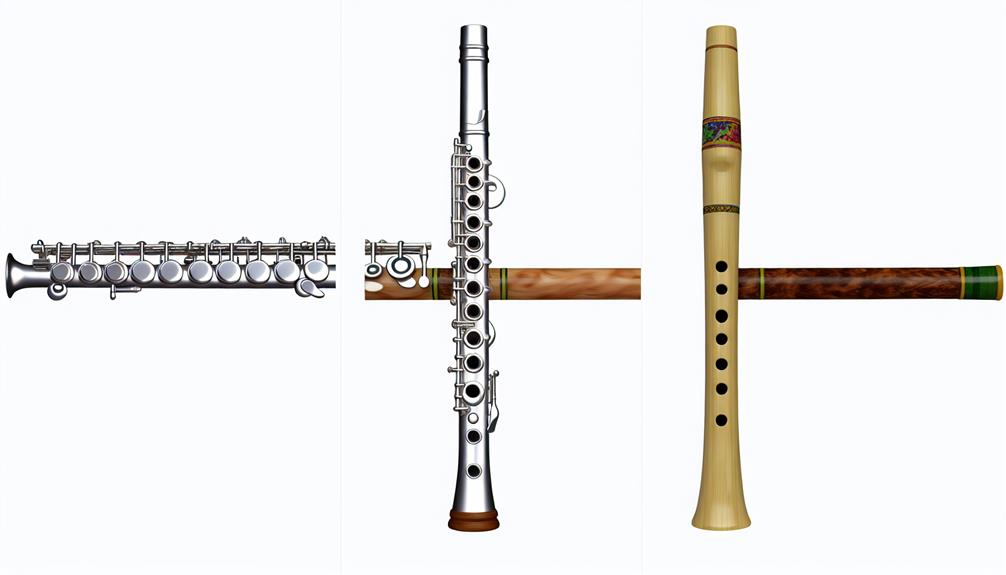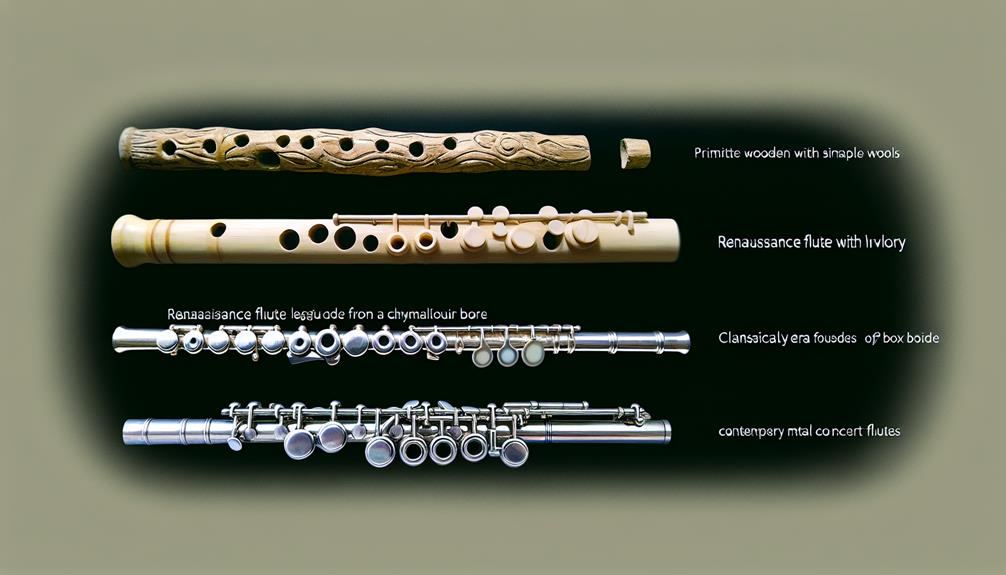Aspiring flutists embarking on their musical journey often seek guidance and structure to navigate the complexities of learning this elegant instrument. The Complete Beginner's Guide to Playing the Flute offers a meticulous roadmap towards mastering the flute, from fundamental techniques to advanced concepts. By exploring topics such as proper flute assembly, basic fingerings, and posture essentials, beginners can lay a solid groundwork for their musical endeavors. This guide not only provides a foundation but also hints at the vast possibilities awaiting those who delve deeper into the world of flute playing.
Key Takeaways
- Understand flute parts and assembly for proper maintenance.
- Focus on holding, posture, and breathing techniques.
- Master producing clear sounds with breath control and embouchure.
- Learn basic fingerings, scales, and music notation.
- Practice simple flute exercises to enhance skills.
Choosing the Right Flute
When embarking on your flute-playing journey, selecting the appropriate flute is paramount to your success as a budding musician. The first step in this process is understanding the different purchasing options available to you. Whether you are considering buying a new flute or a used one, it is essential to prioritize quality and playability. Investing in a well-crafted instrument will not only enhance your playing experience but also contribute to the development of your skills.
Once you have your flute, maintaining it properly is crucial for optimal performance. Regular flute maintenance includes cleaning the instrument, oiling the keys, and checking for any signs of wear and tear. By taking care of your flute, you ensure that it remains in top condition, allowing you to produce the best possible sound.
When it comes to playing the flute, two key elements to focus on are flute embouchure and tone production. Developing a proper flute embouchure involves understanding how to shape your lips and control your breath to produce clear and resonant notes. Additionally, mastering tone production requires practice and attention to detail, as it is essential for conveying emotion and musicality in your playing. By honing these skills, you will be well on your way to becoming a proficient flutist.
Understanding Flute Parts
A fundamental aspect of mastering the flute involves gaining a comprehensive understanding of its various parts and their functions in producing music. To truly appreciate and excel in playing the flute, one must grasp the importance of flute maintenance and care as well as how each part contributes to sound production.
The flute consists of three main parts: the headjoint, the body, and the footjoint. The headjoint contains the embouchure hole where the player blows air, creating vibrations that produce sound. It also houses the lip plate, which helps control the airflow. The body of the flute contains the keys and tone holes that the player covers to alter the pitch of the notes. The footjoint extends the length of the flute and helps in playing lower notes.
Understanding the flute's parts is crucial for proper maintenance and care. Regular cleaning, oiling of keys, and keeping the flute dry are essential for longevity and optimal performance. Additionally, knowing how each part contributes to sound production is key to producing clear and melodious tones.
Proper Flute Assembly
Assembling a flute correctly is essential for ensuring optimal playability and sound quality. To start, familiarize yourself with the flute's parts: headjoint, body, and footjoint. Begin by gently twisting and locking the headjoint into the body, ensuring a snug fit without overtightening. Next, attach the footjoint to the body in the same manner. Proper assembly sets the foundation for a seamless playing experience.
Before assembling, ensure your flute is clean to maintain its longevity and performance. Use a clean, dry cloth to wipe off any dust or moisture. For a deeper clean, utilize specialized cleaning rods and cloths designed for flute maintenance. Regular cleaning prevents buildup that can affect sound quality and playability.
Breath control and embouchure techniques are crucial when assembling your flute. The way you blow into the mouthpiece and shape your lips (embouchure) directly impact tone production. Practice controlled breathing and experiment with different embouchure positions to find what works best for you. Proper breath control and embouchure techniques enhance sound projection and overall musicality.
Holding and Posture
Establishing a comfortable and correct posture while holding the flute is fundamental to maintaining stability and control during play. When holding the flute, remember to sit or stand up straight with your shoulders relaxed. Keep your head level and aligned with your body, allowing for smooth airflow while playing. Proper breathing techniques are essential; take deep breaths from your diaphragm to support a steady airflow.
Additionally, maintaining a proper embouchure is crucial for producing a clear and resonant sound. Your embouchure refers to the positioning of your lips, jaw, and facial muscles around the flute's mouthpiece. Practice routines focusing on embouchure exercises can help strengthen these muscles and improve your overall tone quality.
As you work on your posture and embouchure, consider incorporating performance tips into your practice sessions. Visualizing a confident and relaxed posture while playing can enhance your stage presence and overall performance. Remember to keep your fingers relaxed and close to the keys for swift transitions between notes.
Incorporating these elements into your flute practice will not only improve your playing technique but also enhance your overall musical experience. By prioritizing proper posture, breathing techniques, and embouchure, you set yourself up for success in your flute playing journey.
Producing Your First Sound
To initiate your journey into flute playing, the pivotal moment arrives when you create your first sound with careful breath control and embouchure precision. Mastering the art of producing a clear and resonant sound on the flute requires understanding the importance of proper embouchure techniques and breathing exercises.
Embouchure techniques refer to the way in which you shape your mouth and use your facial muscles to control the airflow into the flute. Begin by forming a small, firm 'O' shape with your lips and directing the air slightly downwards across the blow hole. Experiment with different lip positions and pressures until you find the sweet spot that produces a clear and focused tone.
Breathing exercises are essential for developing the lung capacity and control needed to sustain notes and phrases on the flute. Practice deep diaphragmatic breathing by inhaling deeply through your nose, allowing your abdomen to expand, and then exhaling slowly and steadily while engaging your core muscles. This type of breathing will not only support your sound production but also help you maintain endurance during longer playing sessions.
Basic Fingerings and Scales
Mastering the fundamental fingerings and scales on the flute is a pivotal step towards building a strong foundation in your musical journey. As you delve into the world of flute playing, understanding basic fingerings and scales will not only enhance your playing but also lay the groundwork for more advanced techniques. Here are some key points to consider:
- Breath Control: The flute is unique in that it requires a constant and steady stream of air to produce sound. Practice controlling your breath to maintain a consistent tone and volume while playing different notes.
- Embouchure Technique: Developing a good embouchure is essential for producing clear and resonant flute tones. Focus on forming a proper embouchure by shaping your lips correctly and directing the air towards the flute's embouchure hole.
- Basic Fingerings: Familiarize yourself with the basic fingerings for the different notes on the flute. Practice scales regularly to improve your finger coordination and become more comfortable navigating the instrument.
- Scales Practice: Start with simple scales like C major and gradually progress to more complex scales. Scales practice helps you become familiar with the flute's range and improves your intonation and technique.
Introduction to Music Notation
Understanding music notation is essential for any aspiring flutist looking to expand their musical knowledge and repertoire. Note reading forms the foundation of interpreting and playing music on the flute. Each note on the staff represents a specific pitch, and understanding their placement and duration is crucial for playing melodies accurately. Rhythm, indicated by different note values and time signatures, dictates the timing and duration of each note, adding a sense of structure and flow to the music.
In addition to note reading and rhythm, dynamics and articulation are vital aspects of music notation that bring expression and emotion to flute playing. Dynamics refer to the volume at which notes are played, ranging from soft (piano) to loud (forte), allowing the flutist to create contrast and shape within the music. Articulation, on the other hand, defines how each note is played in terms of attack, release, and duration. Techniques such as staccato (short and detached) or legato (smooth and connected) can vastly alter the musical interpretation.
Simple Flute Exercises
With a solid understanding of music notation under your belt, the next step towards honing your flute skills involves engaging in simple yet effective flute exercises to enhance your playing technique and musical proficiency.
- Breathing Techniques: Proper breathing is essential for flute players. Practice deep breathing exercises to support long phrases and maintain a steady airflow while playing. Start by inhaling deeply through your diaphragm and exhaling slowly to control your airflow.
- Embouchure Practice: Work on developing a strong embouchure to produce clear and resonant tones. Practice forming the correct lip position by gently placing the flute's mouthpiece on your lips and blowing air across the embouchure hole. Focus on achieving a consistent and stable sound.
- Tone Development: Improve your tone quality by practicing long tones. Play sustained notes in different registers of the flute to work on achieving a rich and full sound. Pay attention to your embouchure, air support, and posture to produce a clear and beautiful tone.
- Finger Coordination: Enhance your finger dexterity and coordination by practicing scales, arpeggios, and technical exercises. Work on playing smoothly and evenly across all registers of the flute. Focus on maintaining proper hand position and finger placement to ensure accurate and efficient playing.
Resources for Further Learning
For flute players looking to expand their skills and knowledge, exploring various resources can offer valuable insights and guidance in furthering their musical journey. Online tutorials are a fantastic way to delve deeper into flute playing, providing step-by-step instructions on different techniques, music theory, and even tips for enhancing performance. Websites and platforms dedicated to flute lessons can be a treasure trove of information, catering to all levels of expertise from beginner to advanced players. These online resources often offer practice routines tailored to improve specific aspects of playing, helping players hone their skills effectively.
In addition to online tutorials, understanding flute maintenance is crucial for every player. Proper care and maintenance of the instrument not only ensure its longevity but also contribute to the quality of sound produced. Learning about cleaning, oiling, and handling the flute correctly can prevent damage and optimize performance.
For those seeking to take their flute playing to the next level, exploring advanced techniques is essential. Resources that focus on mastering challenging fingerings, breath control, vibrato, and articulation can help players refine their skills and tackle more complex musical pieces with confidence. By incorporating these resources into their practice routine, flute players can continue to grow and evolve as musicians.
Frequently Asked Questions
Can Playing the Flute Improve My Lung Capacity?
Playing the flute can indeed improve lung capacity. The act of playing requires controlled breathing techniques, which can strengthen the respiratory muscles over time. This results in enhanced lung capacity and overall respiratory function.
Additionally, engaging in breathing exercises specific to flute playing can further aid in improving lung capacity. Consistent practice and proper technique are key to maximizing the respiratory benefits that playing the flute can offer.
Are There Specific Foods That Can Affect Flute Playing?
Diet plays a crucial role in impacting flute performance, particularly in relation to breath control. Certain foods can either enhance or hinder your ability to maintain steady airflow while playing.
Opting for light, easily digestible meals and staying hydrated can positively influence your flute playing. Conversely, heavy or greasy foods may impede breath support and affect the overall quality of your performance.
Making mindful food choices can significantly contribute to your success as a flutist.
How Often Should I Clean My Flute?
Regular maintenance is crucial for optimal flute performance. Establish a maintenance schedule to clean your flute thoroughly at least once a month.
Utilize appropriate cleaning products and follow proper techniques to ensure longevity and functionality. Hygiene practices play a key role in preserving the instrument's quality.
Can I Practice Flute Without Disturbing Others?
Silent practice is a valuable technique for flute players looking to hone their skills without causing disruption. Utilizing soundproofing solutions, such as practice mutes or playing in a designated area with minimal sound leakage, can help maintain peace and harmony in shared spaces.
Is It Common to Experience Hand Fatigue While Playing the Flute?
It is common for flute players to experience hand fatigue, especially when starting out. Proper posture and hand positioning are essential to prevent this.
Incorporating hand exercises and relief techniques can help strengthen muscles and alleviate discomfort. Being mindful of the weight of the instrument and taking breaks during practice sessions can also contribute to reducing hand fatigue.
With practice and attention to these factors, hand fatigue can be managed effectively.
Conclusion
In conclusion, mastering the art of playing the flute requires dedication, practice, and a solid foundation of knowledge.
By following the steps outlined in 'The Complete Beginner's Guide to Playing the Flute,' beginners can confidently navigate the world of music and unlock their full potential as flutists.
With a commitment to learning and exploring new techniques, the journey to becoming a skilled flute player is both rewarding and fulfilling.




